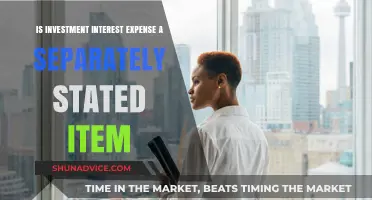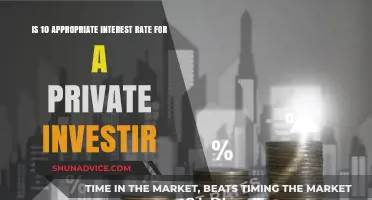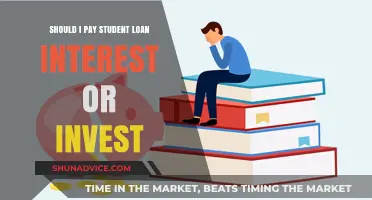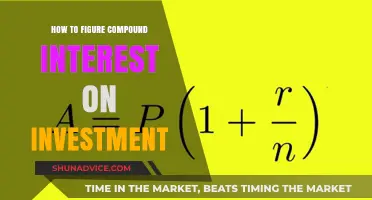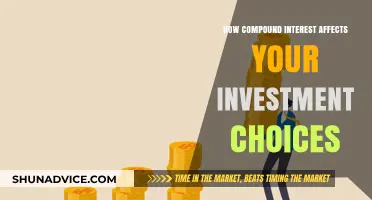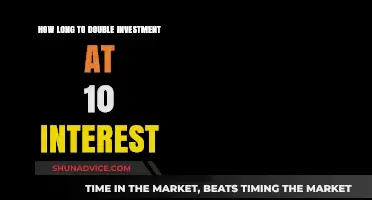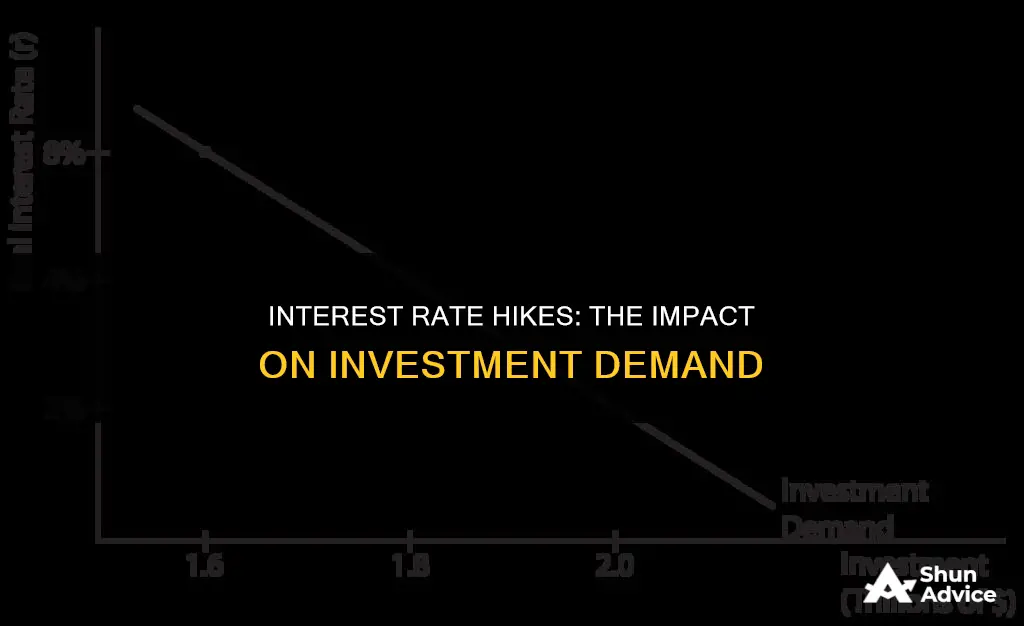
When interest rates rise, the investment demand curve shifts to the left. This is because higher interest rates make borrowing more expensive, which reduces the incentive for businesses to invest in new projects or expand their operations. As a result, the overall level of investment in the economy tends to decrease, leading to a lower equilibrium level of investment demand. This phenomenon is a key aspect of the relationship between monetary policy and economic activity, as central banks often use interest rates as a tool to influence the pace of economic growth and manage inflationary pressures.
| Characteristics | Values |
|---|---|
| Effect on Investment Demand | When interest rates rise, investment demand typically decreases. Higher interest rates make borrowing more expensive, which reduces the incentive for businesses and individuals to invest. |
| Impact on Business Investment | Increased interest rates can discourage business investment in new projects, expansion, or research and development. This is because higher borrowing costs mean higher expenses, potentially reducing profitability. |
| Consumer Spending and Investment | Higher interest rates can lead to reduced consumer spending, as borrowing becomes more costly. This, in turn, may affect investment demand, especially in sectors reliant on consumer confidence. |
| Stock Market and Bond Market | Rising interest rates often lead to a shift from equity (stock) investments to fixed-income securities like bonds. This is because bonds offer a fixed return, which becomes more attractive when interest rates are high. |
| Real Estate Investment | In the real estate sector, higher interest rates can make borrowing more expensive, potentially reducing investment in property development and purchases. |
| Government Spending and Investment | Governments may adjust their spending and investment plans based on interest rate changes. Higher rates might prompt a shift towards more conservative fiscal policies. |
| Inflation and Interest Rates | Increased interest rates can help control inflation by reducing the money supply and borrowing, but this can also impact investment demand negatively. |
| Economic Growth and Investment | Higher interest rates can slow down economic growth, which may indirectly affect investment demand as businesses and consumers become more cautious. |
| Market Sentiment | Rising interest rates can influence market sentiment, potentially causing a shift in investor preferences and investment strategies. |
| Long-term Investment Outlook | Over the long term, higher interest rates can lead to a more cautious investment environment, with investors favoring safer assets and strategies. |
What You'll Learn
- Impact on Borrowing: Higher interest rates reduce investment demand as borrowing becomes more expensive
- Alternative Investments: Increased rates may shift demand to safer, lower-yielding assets like bonds
- Consumer Spending: Higher rates can lead to reduced consumer spending, affecting investment demand
- Business Investment: Firms may cut investment due to higher financing costs and economic uncertainty
- Government Policies: Interest rate hikes can influence government spending and investment decisions

Impact on Borrowing: Higher interest rates reduce investment demand as borrowing becomes more expensive
When interest rates rise, the cost of borrowing increases, which has a direct and significant impact on investment demand. This relationship is fundamental to understanding the broader economic effects of monetary policy. As interest rates climb, the incentive to borrow decreases, as potential borrowers face higher costs associated with financing their projects or ventures. This is particularly true for businesses and individuals who rely on loans to fund their operations, expansion, or personal financial goals.
The higher interest rates make borrowing more expensive, which can lead to a reduction in investment activity across various sectors. For instance, in the business world, companies might postpone new projects or expansion plans because the cost of capital has increased. This is especially true for long-term investments, as the higher interest rates can make these projects less financially viable. Similarly, in the housing market, higher interest rates can discourage potential homebuyers, leading to a decrease in housing investment.
The impact of rising interest rates on investment demand is not limited to the immediate borrowing costs. It also affects the overall economic environment. When interest rates are high, the economy may experience a slowdown in investment, which can lead to reduced economic growth. This is because lower investment can result in decreased production, fewer job opportunities, and a potential decline in consumer spending. As a result, the overall economic health can be negatively impacted, creating a ripple effect that extends beyond the borrowing and investment sectors.
In summary, higher interest rates have a profound effect on investment demand, particularly in the context of borrowing. The increased cost of borrowing discourages investment activity, affecting businesses, individuals, and the broader economy. This relationship highlights the delicate balance between monetary policy and economic growth, as central banks must carefully consider the potential consequences of their interest rate decisions. Understanding this dynamic is crucial for policymakers, businesses, and investors alike, as it can influence strategic decisions and economic planning.
Interest Rate Hikes: Navigating the Impact on Your Investment Portfolio
You may want to see also

Alternative Investments: Increased rates may shift demand to safer, lower-yielding assets like bonds
When interest rates rise, the investment landscape undergoes a significant transformation, particularly in the realm of alternative investments. This shift in interest rates can have a profound impact on the demand for various asset classes, often leading investors to reevaluate their portfolios. One of the most notable effects is the increased demand for safer, lower-yielding assets, such as government bonds.
As interest rates increase, the relative attractiveness of fixed-income securities becomes more pronounced. Bonds, which offer a steady stream of interest payments, become more appealing to risk-averse investors. When rates rise, the existing bondholders are incentivized to lock in higher yields by selling their bonds and purchasing new ones with more attractive rates. This dynamic creates a ripple effect, causing a surge in demand for government bonds and other fixed-income instruments.
The appeal of bonds lies in their perceived safety and stability. In times of rising interest rates, investors often seek the security of guaranteed returns, which bonds typically provide. This is especially true for government bonds, which are considered low-risk investments due to the creditworthiness of the issuing government. As a result, investors may divert their funds from riskier assets, such as stocks or alternative investments, to the relative safety of bonds.
This shift in demand can have a substantial impact on alternative investment sectors. For instance, real estate investment trusts (REITs), which offer exposure to the real estate market, may experience a decline in demand as investors prefer the liquidity and safety of bonds. Similarly, commodities and other raw materials might see reduced interest as investors opt for the more predictable returns of fixed-income securities.
In summary, when interest rates increase, investment demand tends to shift towards safer, lower-yielding assets like bonds. This phenomenon is driven by the desire for stable returns and risk mitigation. As a result, investors may rebalance their portfolios, potentially reducing exposure to alternative investments in favor of the more traditional and secure option of fixed-income securities. Understanding this behavior is crucial for investors and financial advisors to navigate market changes effectively.
Understanding the Difference: Investment vs. Interest Rates
You may want to see also

Consumer Spending: Higher rates can lead to reduced consumer spending, affecting investment demand
When interest rates rise, it often triggers a chain reaction in the economy, particularly impacting consumer spending and, consequently, investment demand. Higher interest rates make borrowing more expensive, which directly influences the spending habits of consumers and businesses. As rates increase, the cost of taking out loans for various purposes, such as purchasing homes, cars, or starting businesses, becomes more expensive. This increased cost of borrowing can lead to a reduction in consumer spending, as individuals and businesses may opt to save more to cover the higher interest expenses.
In the context of consumer spending, higher interest rates can discourage people from making large purchases, especially those that are typically financed through loans. For instance, a person might decide to delay buying a new car or a house because the monthly payments will be higher due to the increased interest rate. This behavior can result in a slowdown in the sales of durable goods, which are often considered a key driver of investment demand. As consumer spending decreases, businesses may experience reduced revenue, potentially impacting their investment decisions.
The relationship between interest rates and consumer spending is particularly crucial in the short term. When rates rise rapidly, consumers may react quickly by adjusting their spending habits. This can lead to a rapid decrease in investment demand, especially in sectors that rely heavily on consumer confidence and spending. For example, industries such as retail, hospitality, and automobile manufacturing might witness a decline in sales and, subsequently, a reduction in their investment activities.
Moreover, the impact of higher interest rates on consumer spending can have a ripple effect throughout the economy. Reduced consumer spending can lead to decreased demand for goods and services, prompting businesses to reevaluate their investment strategies. This may result in a slowdown in business expansion, hiring, and overall investment in new projects. As a result, the overall investment demand in the economy could be significantly affected, potentially leading to a decrease in capital expenditures and a shift towards more conservative financial strategies.
In summary, the relationship between interest rates and investment demand is intricately linked to consumer spending behavior. When interest rates rise, the increased cost of borrowing can lead to reduced consumer spending, which, in turn, affects investment demand. This dynamic highlights the importance of understanding the broader economic implications of monetary policy decisions, especially in sectors that are highly sensitive to changes in consumer behavior and borrowing costs.
Keynesian Economics: Investment and Interest Rates Explored
You may want to see also

Business Investment: Firms may cut investment due to higher financing costs and economic uncertainty
When interest rates rise, the cost of borrowing money for businesses increases, which can significantly impact investment demand. Higher interest rates make it more expensive for firms to finance their operations and expansion plans, leading to a reduction in investment activity. This is particularly true for businesses that rely heavily on debt financing, as the increased cost of borrowing can quickly erode profit margins and make projects less financially viable. As a result, firms may become more cautious and conservative in their investment decisions, focusing on short-term gains and cost-cutting measures rather than long-term growth.
The impact of rising interest rates on investment demand is twofold. Firstly, higher borrowing costs directly affect the profitability of investment projects. With increased interest expenses, businesses may find that the returns on their investments are no longer sufficient to cover the costs, making it challenging to justify new projects. This is especially true for projects with longer payback periods, as the higher interest rates can significantly increase the overall cost of capital. Secondly, the economic uncertainty surrounding rising interest rates can create a ripple effect on investment decisions. Uncertainty about future interest rate movements and the potential for further rate hikes can lead to a more conservative business environment. Firms may delay or cancel investment plans to avoid the risks associated with higher borrowing costs, which could have a negative impact on economic growth and development.
In addition, the relationship between interest rates and investment demand is further complicated by the varying effects on different industries. Some sectors, such as housing and consumer goods, may be more sensitive to changes in interest rates, as these industries often rely on consumer credit and borrowing. When interest rates rise, consumers may be less inclined to take out loans for major purchases, leading to a decrease in demand for these goods and services. This, in turn, can discourage businesses from investing in these sectors, as they may anticipate lower sales and reduced profitability.
Firms may also adjust their investment strategies in response to higher interest rates. Instead of pursuing large-scale expansion projects, businesses might opt for more conservative approaches, such as reinvesting profits into existing operations or exploring cost-saving measures. This shift in strategy can help mitigate the financial risks associated with rising interest rates, but it may also limit the potential for economic growth and innovation. Furthermore, the impact of higher interest rates on investment demand can have broader economic implications. Reduced business investment can lead to slower job creation, decreased productivity, and potential long-term economic stagnation.
In summary, when interest rates increase, businesses may significantly cut investment due to higher financing costs and economic uncertainty. This reduction in investment demand can have a cascading effect on the economy, impacting job creation, productivity, and overall growth. Understanding these dynamics is crucial for policymakers and businesses alike, as it highlights the importance of managing interest rates and providing support to encourage investment during periods of economic uncertainty.
Unraveling Acorn's Interest: A Deep Dive into Investment Rewards
You may want to see also

Government Policies: Interest rate hikes can influence government spending and investment decisions
Interest rate hikes have a significant impact on government policies and their approach to spending and investment. When central banks increase interest rates, it triggers a chain of effects that can influence government behavior and economic strategies. One of the primary consequences is the potential reduction in government borrowing. Higher interest rates make borrowing more expensive, which may discourage governments from taking on additional debt. As a result, they might opt for more prudent fiscal policies, focusing on reducing existing debt or maintaining a balanced budget. This shift in borrowing behavior can have a ripple effect on government investment projects, as reduced borrowing capacity may limit the funds available for large-scale infrastructure or social programs.
In response to rising interest rates, governments often need to reconsider their spending plans. They may need to adjust their budgets to accommodate the higher cost of borrowing. This could lead to a reallocation of resources, where governments might cut back on discretionary spending or delay non-essential projects. For instance, a government might reduce funding for new construction projects or postpone the implementation of proposed social welfare initiatives. Such decisions can have a direct impact on the overall investment climate, as reduced government spending may lead to a decrease in aggregate demand, affecting private sector investments as well.
The relationship between interest rates and government investment is complex. While higher interest rates can make borrowing more expensive, they also encourage savings and can attract foreign investment. This increased capital inflow can provide governments with opportunities to secure funding for their projects at more favorable rates. However, the timing and magnitude of such effects are crucial. If interest rate hikes are sudden and significant, governments might struggle to adapt their investment strategies promptly. This could result in a temporary slowdown in government investment, which may have broader economic implications, especially in sectors that heavily rely on government funding.
Furthermore, the impact of interest rate hikes on government policies extends beyond immediate financial considerations. It can influence long-term economic planning and strategic decision-making. Governments may need to reassess their infrastructure development plans, considering the higher costs associated with borrowing. This could lead to a shift towards more sustainable and cost-effective investment strategies, potentially focusing on public-private partnerships or exploring alternative financing methods. Effective communication and coordination between the government, central bank, and financial institutions become essential during such periods to ensure a smooth transition and minimize economic disruptions.
In summary, interest rate hikes have a profound effect on government policies, particularly in the areas of spending and investment. Governments need to carefully navigate the challenges posed by rising interest rates to ensure economic stability and growth. By understanding the potential consequences, policymakers can make informed decisions regarding fiscal management, which, in turn, can help maintain a healthy investment environment and support overall economic development.
Interest Payable: Operating, Investing, or Financing? Unraveling the Accounting Conundrum
You may want to see also
Frequently asked questions
When interest rates rise, borrowing becomes more expensive, which can lead to a decrease in investment demand. Higher interest rates make it more costly for businesses to take out loans, especially for long-term projects or expansion. This may discourage investment as companies might opt for more immediate, less risky opportunities or even delay their plans until the rates become more favorable.
Rising interest rates often result in a negative reaction in the stock market. Investors might sell their stocks to avoid the potential losses that could arise from higher borrowing costs. This can lead to a decline in stock prices, especially for companies that rely heavily on debt financing. However, some sectors, like utilities and consumer staples, may benefit as they are considered less sensitive to interest rate changes.
Typically, higher interest rates can have a cooling effect on the housing market. Mortgages become more expensive, making it less affordable for potential homebuyers. This may lead to a decrease in demand for housing, potentially causing a slowdown in sales and a drop in property prices.
Increased interest rates can discourage consumer spending, especially on big-ticket items like cars or houses. When borrowing becomes more expensive, individuals might opt to save more and spend less, reducing their overall consumption. This can have a ripple effect on businesses, as reduced consumer demand may lead to lower sales and profits.
When interest rates rise, government bond prices typically fall. This is because new bonds issued at higher interest rates become more attractive to investors, making older bonds with lower yields less appealing. As a result, investors may sell their existing bonds, causing the prices to decrease.


